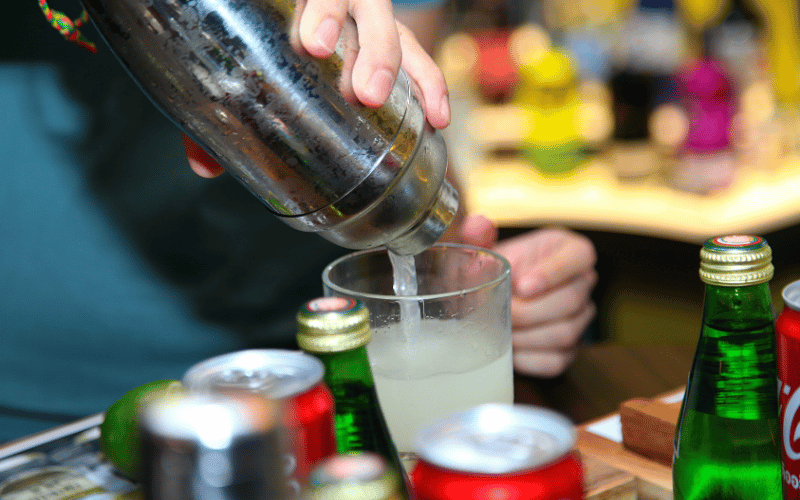เมซคาล

เมซคาล สุราพื้นเมืองของเม็กซิโก มีรากฐานที่หยั่งรากลึกในประวัติศาสตร์และวัฒนธรรมของประเทศ ต้นกำเนิดของเมซคาลย้อนกลับไปถึงยุคก่อนฮิสแปนิก เมื่อชนพื้นเมืองของเม็กซิโกหมักและกลั่นต้นอากาเว่เพื่อสร้างสรรค์เครื่องดื่มที่มีรสชาติเข้มข้น คำว่า "เมซคาล" มาจากคำว่า "เม็กซ์คาลลี" ในภาษานาอัวตล์ ซึ่งแปลว่า "อากาเว่อบ" ต่างจากเตกีลา ซึ่งเป็นเมซคาลชนิดหนึ่งที่ทำจากอากาเว่สีน้ำเงินเฉพาะในพื้นที่ที่กำหนด เมซคาลสามารถผลิตได้จากอากาเว่หลากหลายสายพันธุ์ ทำให้มีรสชาติที่เป็นเอกลักษณ์และหลากหลาย
ขั้นตอนการทำเมซคาล
การผลิตเมซคาลเป็นกระบวนการที่พิถีพิถันซึ่งเกี่ยวข้องกับขั้นตอนสำคัญหลายขั้นตอน:
-
การเก็บเกี่ยว : การเดินทางเริ่มต้นด้วยการเก็บเกี่ยวต้นอากาเว่ ซึ่งอาจใช้เวลา 7 ถึง 25 ปีจึงจะโตเต็มที่ แก่นของต้นอากาเว่ หรือที่รู้จักกันในชื่อ "ปิญญา" จะถูกสกัดและนำมาใช้ในกระบวนการผลิต
-
การคั่ว : ปิญาจะถูกคั่วในหลุมดินขนาดใหญ่ที่บุด้วยหินร้อน ซึ่งจะทำให้เมซคาลมีรสชาติรมควันที่เป็นเอกลักษณ์ กระบวนการคั่วนี้อาจใช้เวลาหลายวัน และเป็นลักษณะเฉพาะของการผลิตเมซคาลแบบดั้งเดิม
-
การบด : หลังจากคั่วแล้ว ปิญาจะถูกบดเพื่อคั้นน้ำ ตามปกติแล้วจะใช้ "ทาโฮนา" ซึ่งเป็นล้อหินขนาดใหญ่ที่ลากด้วยล่อหรือวัว แม้ว่าวิธีการสมัยใหม่อาจใช้เครื่องบดแบบกลไกก็ตาม
-
การหมัก : จากนั้นนำอะกาเว่ที่บดแล้วไปใส่ในถังหมัก แล้วปล่อยให้หมักตามธรรมชาติด้วยความช่วยเหลือของยีสต์ป่า กระบวนการนี้อาจใช้เวลาตั้งแต่ไม่กี่วันไปจนถึงหลายสัปดาห์ ขึ้นอยู่กับอุณหภูมิแวดล้อมและเทคนิคเฉพาะที่ผู้ผลิตเมซคาเลโร (ผู้ผลิตเมซคาล) ใช้
-
การกลั่น : ของเหลวที่ผ่านการหมัก หรือที่เรียกว่า "โมสโต" จะถูกกลั่นในหม้อต้มทองแดงหรือหม้อต้มดินเหนียว โดยทั่วไปเมซคาลจะถูกกลั่นสองครั้งเพื่อให้ได้ความบริสุทธิ์และปริมาณแอลกอฮอล์ตามที่ต้องการ การกลั่นครั้งที่สองมักจะทำอย่างช้าๆ เพื่อให้เมซคาเลโรได้เลือก "หัวใจ" ของการกลั่นอย่างระมัดระวัง ซึ่งมีรสชาติที่ดีที่สุด
-
การบ่ม : เมซคาลสามารถดื่มได้ทันทีหลังการกลั่น ซึ่งเรียกว่า "joven" (เมซคาลอายุน้อย) หรืออาจบ่มในถังไม้โอ๊คเพื่อพัฒนารสชาติที่ซับซ้อนยิ่งขึ้น ระยะเวลาการบ่มแตกต่างกันไป โดยเมซคาลแบบ "reposado" (พักไว้) จะถูกบ่มเป็นเวลา 2 ถึง 12 เดือน และเมซคาลแบบ "añejo" (บ่ม) จะถูกบ่มอย่างน้อยหนึ่งปี
ประเภทของเมซคาลและวิธีการผลิต
เมซคาลจะถูกแบ่งประเภทตามกระบวนการบ่ม ประเภทของอากาเวที่ใช้ และวิธีการผลิต:
-
Joven (Young) : เมซคาลที่ไม่ได้บ่มนี้ใสและโดยทั่วไปจะมีรสชาติเข้มข้นและมีกลิ่นควัน บรรจุขวดหลังจากการกลั่นไม่นาน โดยยังคงรักษากลิ่นบริสุทธิ์ของอะกาเวไว้
-
Reposado (พักไว้) : บ่มในถังไม้โอ๊คเป็นเวลา 2 ถึง 12 เดือน เมซคาล Reposado มีสีทองและรสชาติที่นุ่มนวลและกลมกล่อมพร้อมกลิ่นไม้และเครื่องเทศ
-
Añejo (บ่ม) : บ่มอย่างน้อยหนึ่งปี โดยปกติในถังไม้โอ๊คขนาดเล็ก เมซคาล Añejo จะมีสีเข้มและซับซ้อนกว่า โดยมีรสชาติที่เข้มข้นและล้ำลึกที่ค่อยๆ พัฒนาขึ้นตามกาลเวลา
-
เอสปาดิน : เมซคาลชนิดที่พบมากที่สุด ทำจากต้นอากาเวเอสปาดิน มีประโยชน์หลากหลายและมักใช้เป็นส่วนผสมหลักของเมซคาลหลากหลายชนิด
-
โทบาลา เตเปซตาเต และอะกาเวป่าชนิดอื่นๆ : เมซคาลเหล่านี้ทำจากอะกาเวป่าสายพันธุ์ต่างๆ ซึ่งมักเก็บเกี่ยวจากพื้นที่ห่างไกล โดยทั่วไปแล้วจะมีราคาแพงกว่าและมีรสชาติเฉพาะตัวที่ซับซ้อนซึ่งไม่พบในเมซคาลของเอสปาดิน
วิธีการเลือกเมซคาล
เมื่อเลือกเมซคาล ควรพิจารณาปัจจัยต่อไปนี้:
-
ชนิดของอากาเว่ : อากาเว่แต่ละสายพันธุ์มีรสชาติที่แตกต่างกันออกไป เอสพาดินเป็นพืชที่พบได้ทั่วไปและมีความหลากหลาย ในขณะที่อากาเว่ป่าอย่างโทบาลาและเตเปซตาเตมีรสชาติที่เป็นเอกลักษณ์และซับซ้อนกว่า
-
วิธีการผลิต : วิธีการผลิตแบบดั้งเดิม เช่น การคั่วในหลุมดินและการกลั่นในหม้อดินเผา ล้วนส่งผลต่อรสชาติได้อย่างมาก ลองมองหาเมซคาลแบบดั้งเดิมหรือแบบโบราณเพื่อสัมผัสประสบการณ์ที่แท้จริงยิ่งขึ้น
-
การบ่ม : ตัดสินใจว่าคุณชอบรสชาติที่เข้มข้นและมีกลิ่นควันของเมซคาล Joven หรือรสชาติที่เข้มข้นและมีกลิ่นอายของเมซคาล Reposado หรือ Añejo มากกว่ากัน
-
ภูมิภาค : เมซคาลสามารถผลิตได้ในหลายรัฐของเม็กซิโก แต่ละรัฐมีภูมิประเทศและประเพณีการผลิตที่แตกต่างกัน โออาซากาเป็นที่รู้จักมากที่สุด แต่เมซคาลจากภูมิภาคอื่นๆ เช่น ดูรังโกและเกร์เรโรก็มีความหลากหลายที่น่าสนใจ
ค็อกเทลเมซคาลยอดนิยม
รสชาติควันอันเป็นเอกลักษณ์ของเมซคาลทำให้เป็นส่วนผสมที่มีประโยชน์ในค็อกเทลหลากหลายชนิด ตั้งแต่แบบคลาสสิกไปจนถึงแบบร่วมสมัย:
-
Mezcal Margarita : เครื่องดื่มมาร์การิต้าแบบคลาสสิกที่ผสมกลิ่นควัน โดยทำจากเมซคาล น้ำมะนาว และเหล้าส้ม เสิร์ฟบนน้ำแข็งพร้อมขอบแก้วโรยเกลือ
-
Oaxaca Old Fashioned : ค็อกเทลรสชาติพิเศษที่ประกอบด้วยเมซคาล เตกีลา น้ำเชื่อมอะกาเว และบิตเตอร์ ตกแต่งด้วยกลิ่นส้ม
-
Mezcal Paloma : เครื่องดื่มที่สดชื่นที่ผสมผสานเมซคาล โซดาเกรปฟรุต และน้ำมะนาว เสิร์ฟพร้อมน้ำแข็งและขอบแก้วโรยเกลือ
-
เมซคาลเนโกรนี : เนโกรนีแบบดั้งเดิมที่มีรสชาติรมควัน ทำจากเมซคาล เวอร์มุตหวาน และคัมปารี ตกแต่งด้วยเปลือกส้ม
-
Smoky Mule : เครื่องดื่ม Moscow Mule ที่มีส่วนผสมหลักเป็นเมซคาล ประกอบด้วยเมซคาล เบียร์ขิง และน้ำมะนาว เสิร์ฟในแก้วทองแดง
-
Mezcal Sour : ค็อกเทลเนื้อเนียนฟู ทำจากเมซคาล น้ำมะนาว น้ำเชื่อม และไข่ขาว ตกแต่งด้วยบิตเตอร์เล็กน้อย
เมซคาลเป็นสุราที่น่าหลงใหลและหลากหลาย มีประวัติศาสตร์อันยาวนานและวิธีการผลิตที่เป็นเอกลักษณ์ ไม่ว่าคุณจะชอบดื่มเพียวๆ จิบช้าๆ เพื่อดื่มด่ำกับรสชาติอันซับซ้อน หรือผสมลงในค็อกเทลสุดสร้างสรรค์ เมซคาลก็พร้อมมอบรสชาติที่ถูกใจทุกรสนิยม ด้วยความหลากหลายและรากฐานทางวัฒนธรรมอันลึกซึ้ง ทำให้เมซคาลเป็นสุราที่พิเศษอย่างแท้จริงสำหรับคอลเลกชัน เพลิดเพลินไปกับการสำรวจโลกของเมซคาลและค้นพบเสน่ห์อันน่าหลงใหลและรสชาติอันหลากหลาย ¡Salud!




